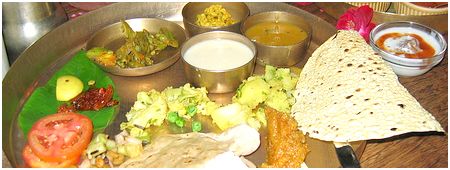Indian Cuisine

Indian Cuisine is characterized by the use of various spices, herbs and other vegetables and sometimes fruits grown in India and also for the widespread practice of vegetarianism across many sections of its society. Each family of Indian cuisine is characterized by a wide assortment of dishes and cooking techniques. As a consequence, it varies from region to region, reflecting the varied demographics of the ethnically diverse Indian subcontinent.
North Indian cuisine :North Indian cuisine is distinguished by the proportionally high use of dairy products; milk, using the "tawa" (griddle) for baking flat breads like roti and paratha, and kulcha, main courses like tandoori chicken also cook in the tandoor. Other breads like puri and bhatoora, which are deep fried in oil, are also common. Goat and lamb meats are favored ingredients of many northern Indian recipes.
East Indian cuisine :East Indian cuisine is famous for its desserts,[citation needed] especially sweets such as rasagolla, chumchum, sandesh, rasabali, chhena poda, chhena gaja, chhena jalebi and kheeri. Many of the sweet dishes now popular in Northern India initially originated in the Bengal and Orissa regions. Apart from sweets, East India cuisine offers delights of posta (poppy seeds).
Traditional cuisines of Assam, Bengal and Orissa delicately spiced. General ingredients used in Assamese, Bengali, and Oriya curries are mustard seeds, cumin seeds, nigella, green chillies, cumin paste and the spice mix panch phoron or panch phutana. Mustard paste, curd, nuts, poppy seed paste and cashew paste are preferably cooked in mustard oil.
South Indian cuisine :South Indian cuisine is distinguished by a greater emphasis on rice as the staple grain, the ubiquity of sambar and rasam (a dish in liquid form prepared with herbs and/or spices, tamarind paste, turmeric and/or tomato and/or dhaal, also called chaaru/saaru and rasam), a variety of pickles, and the liberal use of coconut and particularly coconut oil and curry leaves. Curries called Kozhambu are also popular and are typically vegetable stews cooked with spices, tamarind and other ingredients. The dosa, poori, idli, vada, bonda and bajji are typical South Indian favorites. These are generally consumed as part of breakfast. Other popular dishes include Kesaribath, Upma/Uppittu, Bisibele Bath, Rice Bath, Tomato Bath, Pongal, Poori & Saagu, Pulao, Puliyogarai and Thengai Sadham. Hyderabadi biryani, a popular type of biryani, reflects the diversity of south Indian cuisine. South Indian cuisine obtains its distinct flavours by the use of tamarind, coconut, lentils, and a variety of vegetables.Udupi cuisine is a popular cuisine of South India.
Western Indian cuisine :Western Indian cuisine has three major regions: Gujarati, Maharashtrian and Goan. Maharashtrian cuisine has mainly two sections defined by the geographical sections. The coastal regions, geographically similar to Goa depend more on rice, coconut, and fish. The hilly regions of the Western Ghats and Deccan plateau regions use groundnut in place of coconut and depend more on jowar (sorghum) and bajra (millet) as staples. On various special occasions sweets like pooran poli, shrikhand, modak etc. are prepared. Maharashtrian fast food includes one of the most popular dishes called Pav Bhaji. For breakfast Maharashtrians eat various preparations of rice flakes called Pohe. It is becoming popular in Indian restaurants all around the world. Saraswat cuisine forms an important part of coastal Konkani Indian cuisine. Gujarati cuisine is predominantly vegetarian. Many Gujarati dishes have a hint of sweetness due to use of sugar or brown sugar or gur (also called as jaggery). Goan cuisine is influenced by the Portuguese colonization of Goa. Use of Kokum, triphala is a unique feature of Goan and Konkani cuisine.